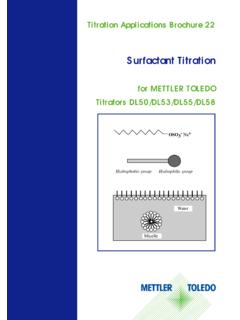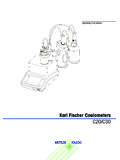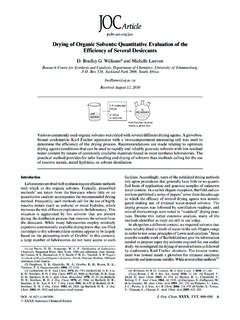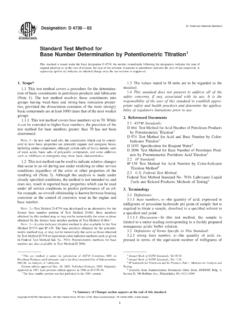Transcription of Karl Fischer Titrators V20/V30 - bikeitech.com
1 V20/V30 karl Fischer TitratorsOperating InstructionsTable of contentsV20/V303 Introduction1 karl Fischer Water Determination Measuring Principle2 Volumetric water content Description of Functions3 Layout of the Operating the The "Home" dialog The User Entering Data in the User Shortcuts and Direct The Start analysis dialog Online Setup (Setup)4 Concentration Titration User Global User Performance of analyses and Monitoring the Expiration Date and Life Span of Monitoring the Expiration Date of a Monitoring the Life Span of a Solvent Auxiliary Service & MT Reset to factory titrator firmware Board Board Table of contents78899999101011111112141415151616 1616192020202121212122222224262627272828 29292930313131313131V20 Manual operations5 Polarized Rinse Methods6 Establishing Modifying or deleting Starting Starting Methods from the Method Terminate Method Syntax Rules for Establishing a Possible Number of Method Types and Possible Number of Sample Method Functions Within a Method Functions Outside of a Overview of Method Method Title Drift Sample (KF)
2 Titration Mix Titration (KF vol) Auxiliary End of Hidden method Series templates7 Sample Sample Analysis Sequences8 Starting an Analysis sequence KF Analysis Series analyses with the "Stromboli" oven sample External Switching between determination Table of contents31313132323233333434353636373838 3839393940404041424243434747474749505050 5253535354545456565757606161V20/V305 Analysis Replacing the Raw results9 All Add Outlier Undo Delete all Evaluate and calculate10 Analysis Indexing of method Naming conventions for using analysis data in Result proposal lists for karl Fischer Internal Using analysis data in Mathematical functions and Subject index11 6161636363646466666667676767697071727274 1 IntroductionSimple and compactThe devices in METTLER TOLEDO's Titration Compact Line are modern.
3 Compact Titrators for use in awide variety of application areas. They can be used, for example, in quality control as well as inresearch and development and satisfy the most demanding of requirements. The Titrators in the Titration Compact Line perfectly combine simple, easy-to-understand operation withan extremely high level of precision and outstanding reliability. Thanks to automatic titrant recognition(Plug & Play burettes), the titrator independently identifies which titrant is required without interventionfrom the operator. Settings no longer need to be adjusted manually, even when connecting a printer or aStromboli oven sample changer. Titration Compact devices can either be controlled by touchscreen or by using LabX PC software. Thelarge color touchscreen allows intuitive control by the user and flexibility in its adjustment options. Allfunctions can be activated directly from the home screen via shortcuts which can be freely created, mak ing everyday use extremely easier.
4 The touchscreen control of the titrator and all adjustable parametersare described in detail in the operating instructions. The separate installation information explains all the necessary steps for installing and commissioningyour device. The enclosed "Quick Guide" then guides you through the first titration using a practicalexample. If you have any additional questions, METTLER TOLEDO is always available to assist karl Fischer Water Determination Measuring PrincipleThe karl Fischer procedure is a titration method used for the quantitative determination of water content inliquids and solids. karl Fischer titration is used in a variety of areas, for determining the water con tent of groceries, chemicals, pharmaceuticals, cosmetics and mineral oils. To determine the water content, first sulfur dioxide and water react with iodine:2 H2O + SO2 + I2 SO42 + 2 I + 4 H+ The addition of alcohol ( methanol, ethanol), causes a preliminary reaction to take place in whichsulfur dioxide forms an acidic ester, which is then neutralized by the addition of a base ( imidazole,referred to in the following as "RN"):CH3OH + SO2 + RN (RNH) (CH3 OSO2)In the presence of water, the alkyl sulfite anion is oxidized to alkyl sulfate by the iodine.
5 This processreduces the yellow-brown iodine to colorless iodide: (RNH) (CH3 OSO2) + I2 + H2O + 2 RN (RNH) (CH3 OSO3) + 2 (RNH) I The overall reaction proceeds as follows: H2O + I2 + SO2 + CH3OH + 3 RN --> [RNH]SO4CH3 + 2 [RNH]I The reaction runs until all the water has been consumed and hence free iodine is detected in the titrationsolution. The end point is determined using bivoltametric indication, the potential at the polarizeddouble-platinum-pin electrode falls below a certain value ( 100mV). Volumetric water content determinationIn karl Fischer (KF) volumetric determination, a titrant containing iodine is gradually added to the water-containing sample until the water is completely displaced and free iodine can be detected in the titrationsolution. The end point of the titration is recorded using bivoltametric indication. Volumetric karl Fischertitration is suitable for samples with a water content in the range 100 ppm to 100 %.
6 The optimumrecording range is 10mg of water per optimal execution of the KF titration, the pH of the solution should be in the range between 4 and and basic samples should be buffered, ideally with imidazole for acids and salicylic acid for following two conventional reagents are used for titration:a) The single-component reagentThe titrant consists of iodine, sulfur dioxide and solvent is single-component reagent is simple to use and cost efficient. However, it is not stable for ) The two-component reagentThe titrant is an iodine solution containing solvent for the sample contains sulfur dioxideand imidazole dissolved in methanol. The two-component system can be used to perform very fast titrations (two to three times quicker thanwith the single-component reagent). Both components can be easily stored. The reagent is stable fortitration,however, the solvent capacity is Fischer Water Determination Measuring Principle3 Description of Layout of the TerminalThe control panel of the terminal consists of an integrated touchscreen and the following buttons, locatednext to the touch-sensitive surface of the display: The Reset button ends all tasks that are currently running.
7 The Info button accesses the interactive online help for the content of the current dialog. Two Home buttons always return you to the home dialog window. You can press these buttons any time, regardless of which dialog you are currently using. The Reset button acts as an "EMERGENCY STOP" switch. If the titrator malfunctions or there is an oper ating error, you can stop all current tasks by pressing the reset button. Afterward, for each task, you candecide whether to end it completely or Operating the TouchscreenThe titrator is operated only via the touchscreen, which is activated automatically when the titrator isswitched select a button or an input element in the dialog window, you simply touch the screen using a softblunt object or a fingertip. Never touch the surface of the touchscreen with pointed or sharp objects! This may damage the screen! The "Home" dialog windowHome is the first screen that is displayed when you start up the titrator .
8 Home contains five buttons that lead to the following dialog windows: Methods: This button takes you to the Method Editor, where you can create and manage methods(see "Methods"). Series Templates: In this dialog, you can create and manage series of individual samples, forusing a sample changer (see "Series Templates"). Results: You manage the results of your analyses here (see "Results"). Setup: The hardware and resources the titrator uses are configured in the Setup. You can also makeglobal and user settings here (see "Setup"). "Manual": This button takes you to manual operations. You can operate stirrers, sensors, pumps,etc. here, independently of the analyses (see "Manual Operations").In addition, there is another area that can be configured individually by each user (with the necessaryauthorization). Each user can store up to 12 shortcuts here. You can use this shortcut to launch definedmethods, series, and manual operations directly from the home dialog (see "Shortcuts and Direct Short cuts").
9 By pressing the Home key in the terminal control panel, you can return to the Home dialog from The User Interface The graphical user interface consists of the following five basic elements: The title bar at the top of the display specifies the name of the current dialog. In the top right-hand corner, the Tasks button informs you which processes are currently use Tasks to access a Tasks dialog that displays an overview of all running tasks. From theTasks dialog you can navigate to any process that is currently of Functions The navigation bar, located below the title bar, specifies the path to the current dialog. The scroll bar on the right-hand side of the screen becomes visible if the content of the screenextends beyond the viewable area. If this occurs, use either the arrows or the area in between them tomove the viewable area of the screen up or down.
10 Five buttons are located at the bottom of the screen. The function of these buttons varies anddepends on the context of the current Entering Data in the User are different types of input fields in the user interface. They allow you to enter data or select datafrom a list. Input fields can also be deactivated and their contents are then displayed as information onlyand cannot be changed in the corresponding various types of input fields are identified by an icon to the right of the screen:Text input fields Any text comprised of letters, numbers and symbols can beentered into these input fields Numbers, formulas and auxiliary values can be entered intothese fields. In some fields an auxiliary value can be selectedfrom the Auxiliary Values list by pressing the "H" lists Selecting these fields opens a drop-down list from which youcan select an fields Selecting these fields opens a menu list in a new window.







